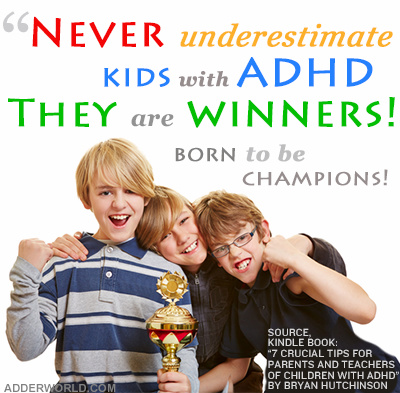What is ADHD?
ADHD is a condition of the brain that affects a person's ability to pay attention. It is most common in school-age children.
What are some signs or symptoms of ADHD?
ADHD is a chronic disorder, meaning that it affects an individual throughout life. The symptoms are also pervasive, meaning they occur in multiple settings, rather than just one.
Current research supports the idea of two distinct characteristics of ADHD, inattention and/or hyperactivity-impulsivity. A child with these characteristics typically demonstrates the following signs:
Inattention
- Has difficulty concentrating
- Has unrelated thoughts
- Has problems focusing and sustaining attention
- Appears to not be listening
- Performance depends on task
- May have better attention to enjoyed activities
- Has difficulty planning, organizing, and completing tasks on time
- Has problems learning new things
- Demonstrates poor self-regulation of behavior, that is, he or she has difficulty monitoring and modifying behavior to fit different situations and settings
Hyperactivity
- Seems unable to sit still (e.g., squirming in his/her seat, roaming around the room, tapping pencil, wiggling feet, and touching everything)
- Appears restless and fidgety
- May bounce from one activity to the next
- Often tries to do more than one thing at once
Impulsivity
- Difficulty thinking before acting (e.g., hitting a classmate when he/she is upset or frustrated)
- Problems waiting his/her turn, such as when playing a game
ADHD is diagnosed by the child's doctor, with input from the family and other professionals. These professionals include the following:
- speech-language pathologists (SLPs)
- regular, special education, and resource teachers
- nurses
- psychologists
- employers (when applicable)
Assessments by the SLP may include some or all of the following:
- Observing the interactions with peers and authority figures in the classroom/work setting and during formal testing
- Observing conversation with parents and other family members
- Interviewing parents/caregivers about speech and language development
- Interviewing the child to evaluate self-awareness of needs and difficulties, as age appropriate
- Formally evaluating speech and language skills, such as fluency (whether or not child stutters), speech articulation (pronunciation and clarity of speech), understanding and use of grammar (syntax), understanding and use of vocabulary (semantics ), awareness of speech sounds (phonemic awareness)
- Evaluating the ability to explain or retell a story, centering on a topic and chaining a sequence of events together
- Assessing social communication skills (pragmatic language)
- Discussing stories and the points of view of various characters
- Assessing the ability to plan, organize, and attend to details
What speech and language treatments are available for people with ADHD?
Specific speech and language patterns vary from child to child with ADHD. For example, some children with ADHD also have learning disabilities that affect their speech and language. Evaluation of each child's individual speech and language ability is critical to developing an appropriate treatment plan.
Speech and language intervention for the person with ADHD is always individualized, as each person has different needs.
- A physician will work with the family and student to prescribe medication, if needed, to help with attention. If medication is prescribed, the SLP will work with other educational professionals to observe the student's pre- and post-medication behavior. As part of the educational team, the SLP will communicate with the family and physician regarding any post-medication behavioral changes. Is the student drowsy? Is sustained attention better/worse? How long does it take for the medication to take effect? The physician will use these observations to adjust dosage, the time medications are administered, and which medication is used.
- The SLP, along with other team members, will work with the teacher to change the classroom environment as needed (e.g., sitting the student in the front of the classroom, having the student repeat directions before following them, using checklists and other visual organizers to help with planning and follow-through).
- Speech-language treatment will focus on individualized language goals, such as teaching better communication in specific social situations, and study skills (planning/organizing/attention to detail). Again, language goals will differ depending on the needs of the individual student.
What other organizations have information about ADHD?
This list is not exhaustive and inclusion does not imply endorsement of the organization or the content of the Web site by ASHA.
- A.D.D. Warehouse
- Children and Adults with Attention Deficit/Hyperactivity Disorder (CHADD)
- NIMH-Attention Deficit Hyperactivity Disorder
- LD Online
- One ADD Place
In most cases, the cause of ADHD is unknown. The most likely cause of ADHD appears to be genetics. Many children with ADHD have a family history of the disorder or behaviors associated with ADHD.
Information about the incidence and prevalence of ADHD is available in the ASHA report Incidence and Prevalence of Speech, Voice, and Language Disorders in Adults in the United States.

Senaste kommentaren
Jag skulle kunna lyssna på dig om och om igen
Så duktig du är! Vad kul🙃
Bra och intressanta punkter..
Fortsätt 🙂
Vi saknar dig oxå uffe kramar från oss
